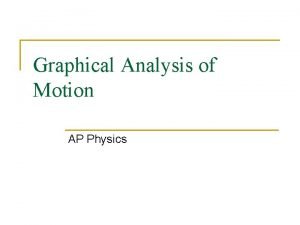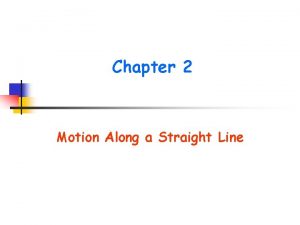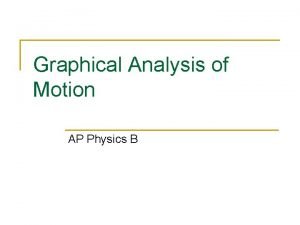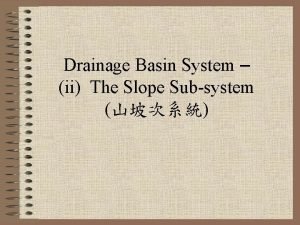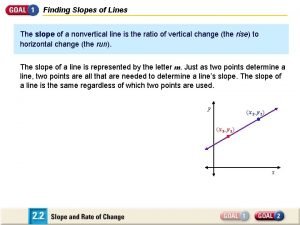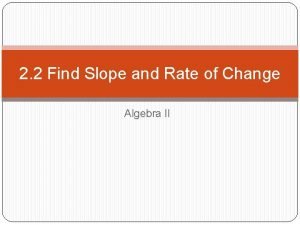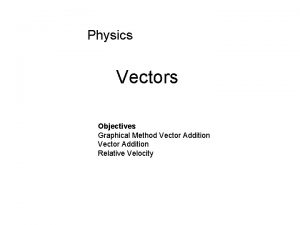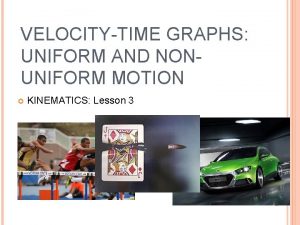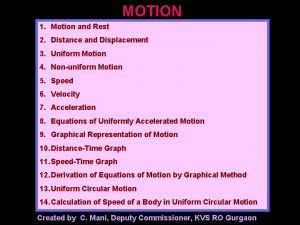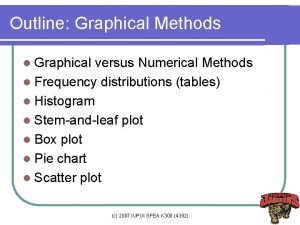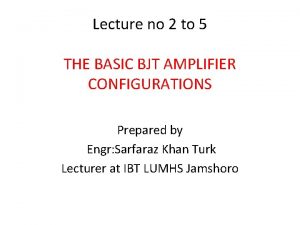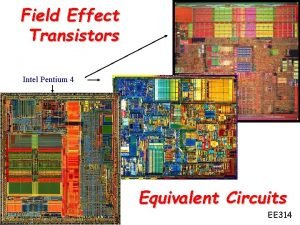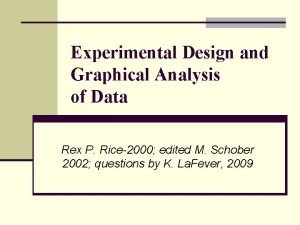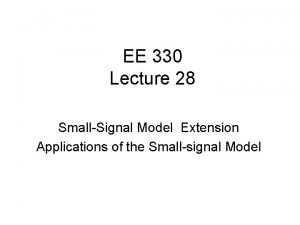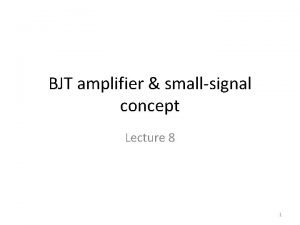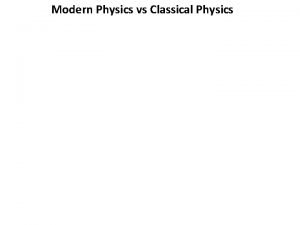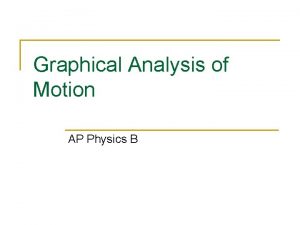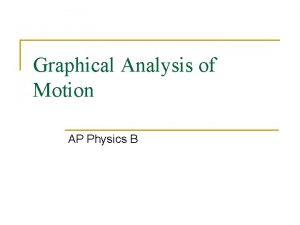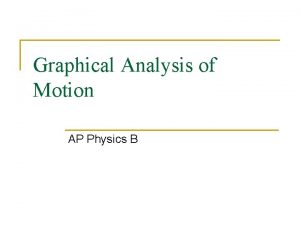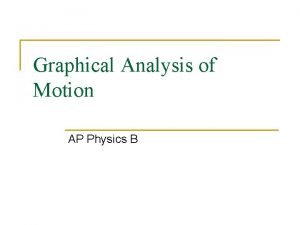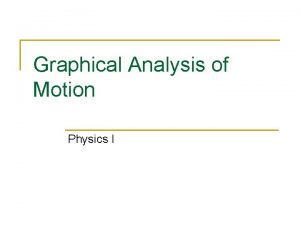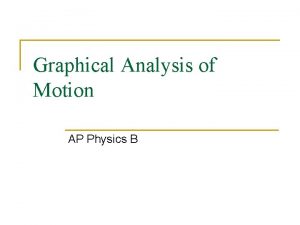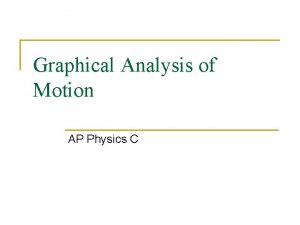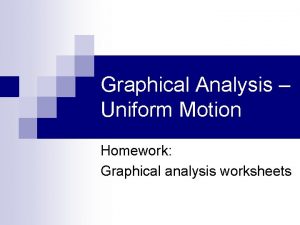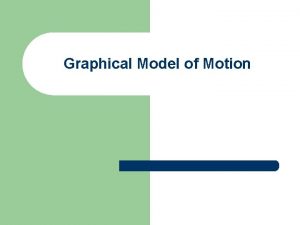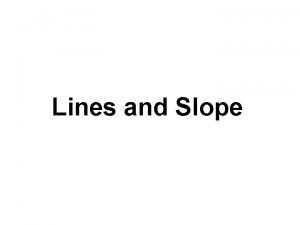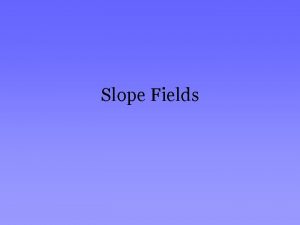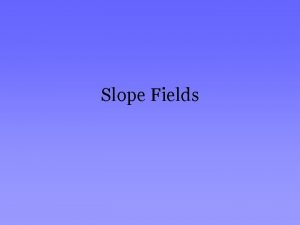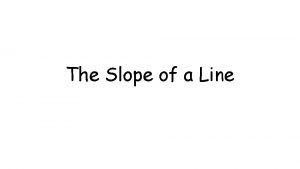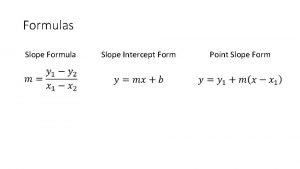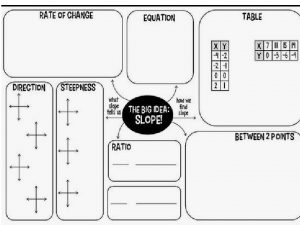Graphical Analysis of Motion AP Physics Slope A


















- Slides: 18

Graphical Analysis of Motion AP Physics

Slope – A basic graph model A basic model for understanding graphs in physics is SLOPE. Using the model - Look at the formula for velocity. Who gets to play the role of the slope? Velocity Who gets to play the role of the y-axis or the rise? Displacement Who get to play the role of the x-axis or the run? Time What does all the mean? It means that if your are given a Displacement vs. Time graph, to find the velocity of an object during specific time intervals simply find the slope.

Displacement vs. Time graph What is the velocity of the object from 0 seconds to 3 seconds? The velocity is the slope!

Displacement vs. Time graph What is the velocity of the object from 7 seconds to 8 seconds? Once again. . . find the slope! A velocity of 0 m/s. What does this mean? It is simple. . the object has simply stopped moving for 1 second.

Displacement vs. Time graph What is the velocity from 8 -10 seconds? You must remember! To find the change it is final - initial. The answer is negative! It is no surprise, because the slope is considered to be negative. This value could mean several things: The object could be traveling WEST or SOUTH. The object is going backwards - this being the more likely choice! You should also understand that the slope does NOT change from 0 -3 s , 5 to 7 s and 8 - 10 s. This means that the object has a CONSTANT VELOCITY or IT IS NOT ACCELERATING.

Example It is very important that you are able to look at a graph and explain it's motion in great detail. These graphs can be very conceptual. Look at the time interval t = 0 to t = 9 seconds. What does the slope do? It increases, the velocity is increasing Look at the time interval t = 9 to t = 11 seconds. What does the slope do? No slope. The velocity is ZERO. Look at the time interval t = 11 to t = 15 seconds. What does the slope do? The slope is constant and positive. The object is moving forwards at a constant velocity. Look at the time interval t = 15 to t = 17 seconds. What does the slope do? The slope is constant and negative. The object is moving backwards at a constant velocity.

Slope – A basic graph model Let’s look at another model Who gets to play the role of the slope? Acceleration Who gets to play the role of the y-axis or the rise? Velocity Who get to play the role of the x-axis or the run? Time What does all the mean? It means that if your are given a Velocity vs. Time graph. To find the acceleration of an object during specific time intervals simply find the slope.

Velocity vs. Time Graph What is the acceleration from 0 to 6 s? What is the acceleration from 6 to 9 s? You could say one of two things here: The object has a ZERO acceleration The object has a CONSTANT velocity What is the acceleration from 14 to 15 s? A negative acceleration is sometimes called DECELERATION. In other words, the object is slowing down. An object can also have a negative acceleration if it is falling. In that case the object is speeding up. CONFUSING? Be careful and make sure you understand WHY the negative sign is there.

Velocity vs. Time Graph Conceptually speaking, what is the object doing during the time interval t = 9 to t = 13 seconds? Does the steepness or slope increase or decrease? The slope INCREASES! According to the graph the slope gets steeper or increases, but in a negative direction. What this means is that the velocity slows down with a greater change each second. The deceleration, in this case, get larger even though the velocity decreases. The velocity goes from 60 to 55 ( a change of 5), then from 55 to 45 ( a change of 10), then from 45 to 30 ( a change of 15), then from 30 to 10 ( a change of 20). Do you see how the change gets LARGER as the velocity gets SMALLER?

Area – the “other” basic graph Another basic model for understanding graphs in model physics is AREA. Let's try to algebraically make our formulas look like the one above. We'll start with our formula for velocity. Who gets to play the role of the base? Time Who gets to play the role of the height? Velocity What kind of graph is this? A Velocity vs. Time graph ( velocity = yaxis & time = x-axis) Who gets to play the role of the Area? Displacement

Example What is the displacement during the time interval t = 0 to t = 5 seconds? That happens to be the area! What is the displacement during the time interval t = 8 to t = 12 seconds? Once again. . . we have to find the area. During this time period we have a triangle AND a square. We must find the area of each section then ADD them together.

Area – the “other” basic graph Let's use our new model again, but for our equation for model acceleration. What does this mean? Who gets to play the role of the base? Time Who gets to play the role of the height? Acceleration What kind of graph is this? An Acceleration vs. Time graph ( acceleration = y-axis & time = x-axis) Who gets to play the role of the Area? The Velocity

Acceleration vs. Time Graph What is the velocity during the time interval t = 3 and t = 6 seconds? Find the Area!

Summary There are 3 types of MOTION graphs n Displacement(position) vs. Time n Velocity vs. Time n Acceleration vs. Time There are 2 basic graph models n Slope n Area

sl area = x t (s) a (m/s/s) = a v (m/s) op e sl x (m) = v Summary t (s) area = v t (s)

Comparing and Sketching graphs op e sl x (m) = v One of the more difficult applications of graphs in physics is when given a certain type of graph and asked to draw a different type of graph List 2 adjectives to describe the SLOPE or VELOCITY 1. The slope is CONSTANT 2. The slope is POSITIVE t (s) How could you translate what the SLOPE is doing on the graph ABOVE to the Y axis on the graph to the right? v (m/s) t (s)

Example v (m/s) x (m) t (s) 1 st line • The slope is constant • The slope is “-” 2 nd line • The slope is “ 0” 3 rd line • The slope is “+” • The slope is constant

Example – Graph Matching What is the SLOPE(a) doing? a (m/s/s) The slope is increasing v (m/s) t (s) a (m/s/s) t (s)
 Slope formula physics
Slope formula physics What is motion along a straight line
What is motion along a straight line Slope
Slope Slope decline
Slope decline Converting point slope to slope intercept
Converting point slope to slope intercept Slopes of lines
Slopes of lines Slope review classifying slope
Slope review classifying slope Graphical method of vector addition
Graphical method of vector addition Uniform speed graph
Uniform speed graph Comic strip showing uniformly accelerated motion
Comic strip showing uniformly accelerated motion Graphical and numerical methods
Graphical and numerical methods Structured analysis tools
Structured analysis tools Basic bjt amplifier
Basic bjt amplifier Graphical analysis
Graphical analysis Pentium 4 transistors
Pentium 4 transistors Experimental design and graphical analysis of data
Experimental design and graphical analysis of data Graphical analysis
Graphical analysis Bjt example
Bjt example Why does it happen
Why does it happen
